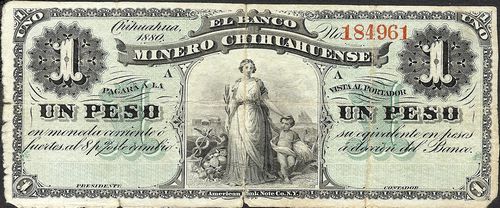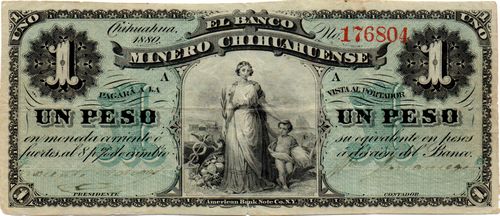1885 robbery

M147a one of the stolen Banco Minero Chihuahuense $1 notes
On the night of 26 April 1885 a large number of 25c, 50c and (green) $1 notes were stolen from a strongbox in the Customs House in El Paso del Norte (Ciudad Juárez). The notes had yet to be signed and did not have the stamp of the Administración de Rentas.
The 50c notes were soon recovered. The serial numbers of the other values were 25c Series A 304501 to 320000, and $1 Series A 144001 to 200000, making a total value of $59,875.
These notes had originally been imported through Presidio to Chihuahua City, but when Inocente Ochoa took over the concession for the Banco Minero Chihuahuense from Herrera y González in 1882, he arranged for them to be transferred to Ciudad Juárez. On 5 March 1885 Ochoa informed the Customs House in Ciudad Juárez that the bank was returning its place of operations back to Chihuahua City and requested that he be allowed to send back two boxes containing unsigned banknotes.
Customs agreed, provided that Ochoa lodged a bond, but Ochoa baulked at the size of the bond and asked for delivery of the packages, for which only $88.98 duty was due, but the customs told him that they could no longer deliver them, until he proved their origin. Customs told this to their counterparts in Chihuahua on 5 March. They also told Chihuahua that Ochoa had not provided the bond and so they had not released the packages.
As Ochoa was unavailable and did not reply as to origin, the matter was to be referred to the district court and the packages would remain in the Customs House, in constant view, rather than being sent to the warehouse that did not have bars on its windows. On 27 March the second commander of the guard reported that one of the boxes had been missing since the previous day. The administrator informed Ochoa’s clerk, the jefe político, and the Mexican consul across the border in El Paso.
On investigation, an employee of the casa Francisco Armendais, next door to the Customs House, found a package containing five hundred sheets of unsigned 50c notes. Also, it was obvious that the robbers had entered through the back of the Customs, though a door which gave onto a field, where the investigators found footprints and some fragments of wood from the broken boxEl Siglo Diez y Nueve, 6 May 1885.
On 29 April E. Loaeza, the customs administrator, reported to the Secretario de Hacienda in Mexico City that the district judge had told him that the El Paso police suspected a Mexican called Alejando Daguerre y Guerra and three Americans who lived with him, one of whom was called Jackibid.. This will have been Alejandro Librado Daguerre, born in 1848 to Alexandre Guillaume Daguerre Duyau, a French political exile, and his first wife, Carmen Guerra. On 15 November 1849 Alejandro’s father had married a second time to Maria del Refugio Samaniego, the sister of Mariano Samaniego, so Alejandro had a close relationship to one of the bank’s owners. The Daguerre home in Ciudad Juárez was very large and well furnished, reflecting the owner's prosperity in the freighting businessEl Paso Herald, 9 January 1974.
Inocente Ochoa and Mariano Samaniego offered a reward of $200 for information leading to the discovery of the notes or arrest of those responsibleEl Tiempo, Mexico City, 14 May 1885. In May a Mexico City newspaper reported that over half the amount had been recovered and that the El Paso Times said that ten thousand dollars had been found in a public houseThe Two Republics, 10 May 1885.
The bank notified the authorities throughout the state of the loss. However, notes with false signatures (but without the Administración General de Rentas stamp) began to appear. Apparently the 25c notes were commonly found in the small change in Allende and on 9 November Gumesindo Loya was arrested in Parral after buying some cheese in Conchos with forty-two $1 notesAMP, Judicial, caja , exp.

M147a one of the stolen $1 notes with (very plausible) signatures of Ochoa and Samaniego
In September 1885 a Mexico City newspaper reported that the police in Chihuahua had recovered a large number of the notes, which had been cancelled (inutilizados)El Tiempo, 25 September 1885. In October 1885 an El Paso newpaper reported that the police in Chihuahua had gathered a quantity of counterfeit banknotes of the Banco Minero (The El Paso Daily Times, 8 October 1885). This probably refers to these stolen, rather than counterfeit, notes.. The actual thieves were apprehended in Pinos Altos 18 months after the robbery and sentenced to prison in Ciudad ChihuahuaEl Correo de Chihuahua, 13 August 1908.
In August 1886 an El Paso newspaper, in giving the local rates of exchange, had Mexican silver and Banco Nacional notes at 70-71c, Banco de Santa Eulalia and Banco Mexicano notes at 60-61c, but Banco Minero Chihuahuense notes were so abundant that dilapidated ones (hecho garras) were 0-2c while clean, untorn peso notes were 59c and clean, untorn centavo notes 6c. Across the border in El Paso nobody was either accepting or giving out Banco Minero Chihuahuense notesEl Tiempo, Mexico City, 21 August 1886, quoting Observador Fronterizo of Ciudad Juárez. Was this a consequence of the robbery or of rash issuing?
